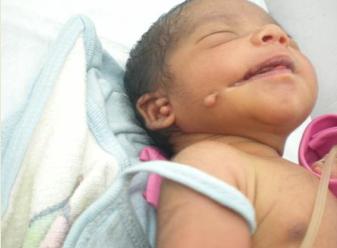Deepak Kumar1, Sonika Gupta2, Niraj Gupta2.
1Department of Paediatrics, SMGS Hospital, Jammu,
2Department of Gynaecology and Obstetrics, MGM Hospital, Kathua.
ADDRESS FOR CORRESPONDENCE
Dr. Deepak Kumar, H.No. 281-a, Vikram Nagar, Sarwal Jammu, 180005. India.
Email: mithssoni@gmail.com | A 4 day old neonate was brought with the history of having yellowish discolouration of skin since 1 day. He was the product of a normal delivery and had facial cleft on right side along with preauricular tags and facial tag on the right side. His cardiovascular status was normal and he had no other apparent congenital malformation. His serum bilirubin value was 13mg% with no blood group incompatibility and G6PD levels were normal. Abdominal ultrasonography didn't reveal any congenital renal malformation and radiographs of the cervical spine were also normal. Antenatal history was also normal. The infant was diagnosed with having Goldenhar syndrome with physiological jaundice.

Goldenhar syndrome also known as oculo-auriculo-vertebral syndrome is a sporadic or autosomal dominant syndrome. It is associated with abnormalities of first and second brachial arches and is characterized by unilateral or bilateral microtia/anotia/atresia, preauricular tags, facial tags, conductive hearing loss, epidermal lipodermoids, microphthalmia, mandibular hypoplasia, maxillary hypoplasia, macrostomia, cervical vertebral anomalies and congenital heart disease (1). An accessory tragus is consistently found in Goldenhar syndrome (2). Over 90% of these infants have ear abnormalities (small or unusually shaped ears, preauricular tags, and pits). Congenital heart disease may be present in one third of the infants. More than 80% of the infants have normal intelligence (3). The cause of Goldenhar syndrome is largely unknown. However, it is thought to be multifactorial, although there may be a genetic component, which would account for certain familial patterns. It has been suggested that there is a brachial arch development issue late in the first trimester. An increase in Goldenhar syndrome in the children of Gulf War veterans has been suggested but the difference was shown to be statistically insignificant (4). | | | | Compliance with Ethical Standards | | Funding None | | | | Conflict of Interest None | | |
- Michael LC. Craniofacial Disorders. In: Rudolph CD, Rudolph AM (eds). Rudolph's Pediatrics. 21st edn. McGraw Hill. 2003: 2878-2905.
- Joseph GM. Cutaneous Defects. In: Kliegman RM, Behrman RE, Jenson HB (eds). Nelson Textbook of Pediatrics. 18th ed. Saunders Elsevier. Philadelphia. 2007: 2664-2666.
- Non Chromosomal Syndromes, Associations, and Sequences. Ralph DF. Atlas of the Newborn, Vol 2. B.C.Decker Inc. London. 1997: 87-159. [PMC free article]
- Araneta MR, Moore CA, Olney RS, Edmonds LD, Karcher JA, McDonough C, et al. " Goldenhar syndrome among infants born in military hospitals to Gulf War veterans. Teratology. 1997; 56: 244-251. [CrossRef]
DOI: https://doi.org/10.7199/ped.oncall.2012.24
|
| Cite this article as: | | Kumar D, Gupta S, Gupta N. Goldenhar Syndrome. Pediatr Oncall J. 2012;9: 45. doi: 10.7199/ped.oncall.2012.24 |
|